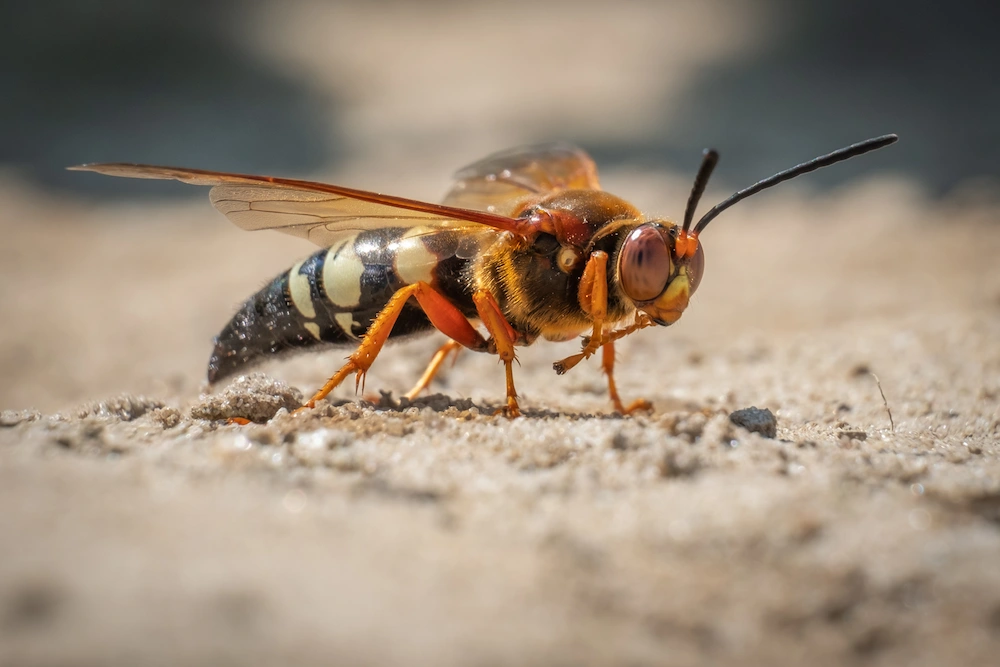Summary: The summer temperatures are officially heating up, which gives stingers more energy. This blog explains the basics of 6 infamous stingers in Texas, so homeowners know which type they’re facing. Romney Pest Control solves these pest issues with complete efficiency and care.
Summer is a season of sunshine, sweet tea, and stinging pests. Texas is home to quite a few stinging species, and it’s a good idea to know the key differences between the main stingers and their lifestyles. Some insects are angrier than others, and these differences are heightened when the pests live in your yard. After all, nothing ruins a pool party or backyard barbecue faster than a wasp infestation!
Let’s break down the basics of the 6 most common stingers in Texas so you know what you’re facing the next time your yard is visited by stingers.
Paper Wasps
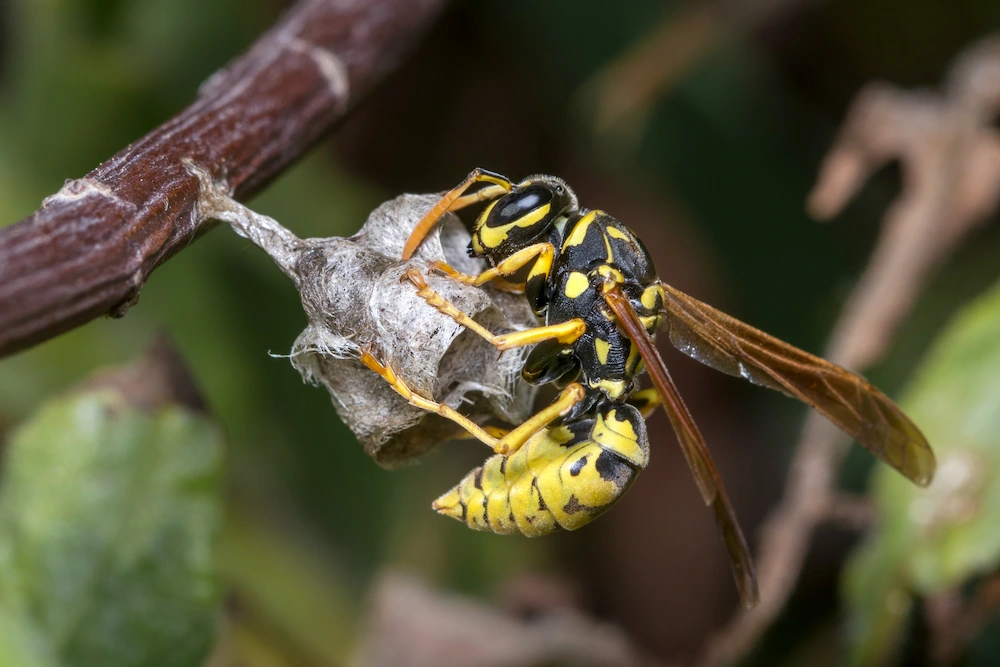
Wasps in general are very common in our state. The high temperatures and abundant plant life make it easy for them to establish colonies wherever they want. Since paper wasps are seen as the most common Texas wasp species, we’ll focus on them here.
Appearance: Paper wasps are about an inch long with dark wings. They’re dark brown with yellow markings, so they look a little different from the usual yellow-and-black wasps. When they’re at rest, paper wasps fold their wings against their bodies.
Diet: These wasps are omnivores, like most types of wasps and hornets. They eat pollen, nectar, plant matter, bugs, and organic trash.
Habitat: Their dense nests are made of chewed cellulose (a main ingredient in wood) or plant material and saliva. These umbrella-shaped nests are often in yards and gardens. Paper wasps keep them elevated by hanging them on eaves, door frames, voids, attics, and window sills.
Risks: Paper wasps are naturally defensive of their colony and nest. If either is disturbed, they will sting the threat multiple times. That being said, they’re not the most aggressive pests of the bunch. They don’t want anything to do with us if they’re left alone. The queen is the only one who survives the winter, so paper wasps start new colonies every year.
Yellow Jackets
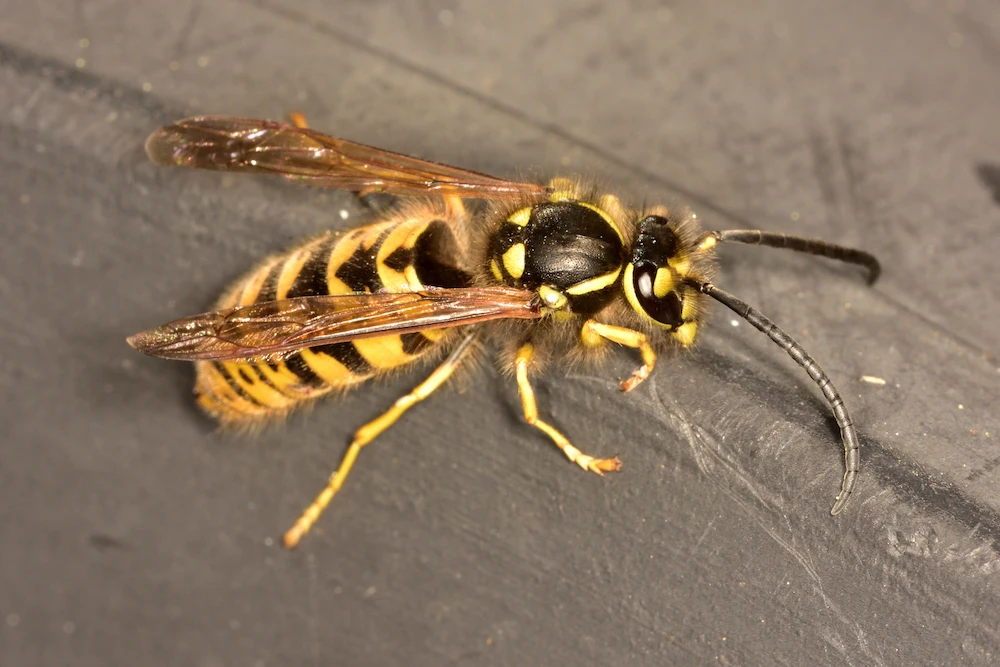
These are the stingers we know (and worry about) the most. Yellow jackets have the classic markings and bad attitudes that we associate with stinging pests. The best defense against these insects is using your knowledge of their habits to avoid their hangouts.
Appearance: Yellow jackets have the signature yellow-and-black coloring we mentioned earlier. They’re about 1/2 to 3/4 of an inch long. Their slender, hairless bodies move like flying darts, thanks to their strong wings that make them speedy fliers.
Diet: These scavengers are often seen hovering above a food source before they decide to land. They eat bugs, meat, nectar, pollen, fruit, and pet food. Their nickname “meat bees” comes from their tendency to incessantly hover above meats and pet food.
Habitat: Unlike other pests, yellow jackets usually nest underground. Their papery nests are made of cellulose and saliva and have just one opening. The usual spots are ground holes, tree or log hollows, wall voids, tree branches, and empty rodent burrows.
Risks: Yellow jackets are always on the defensive. They sting multiple times when provoked, especially if it’s near their nest. They’re even more aggressive in the fall when their food supply runs low. While they help keep the insect population down, yellow jackets are not a pest you want to have. It doesn’t help that there’s usually thousands of them in one nest.
Cicada Killers
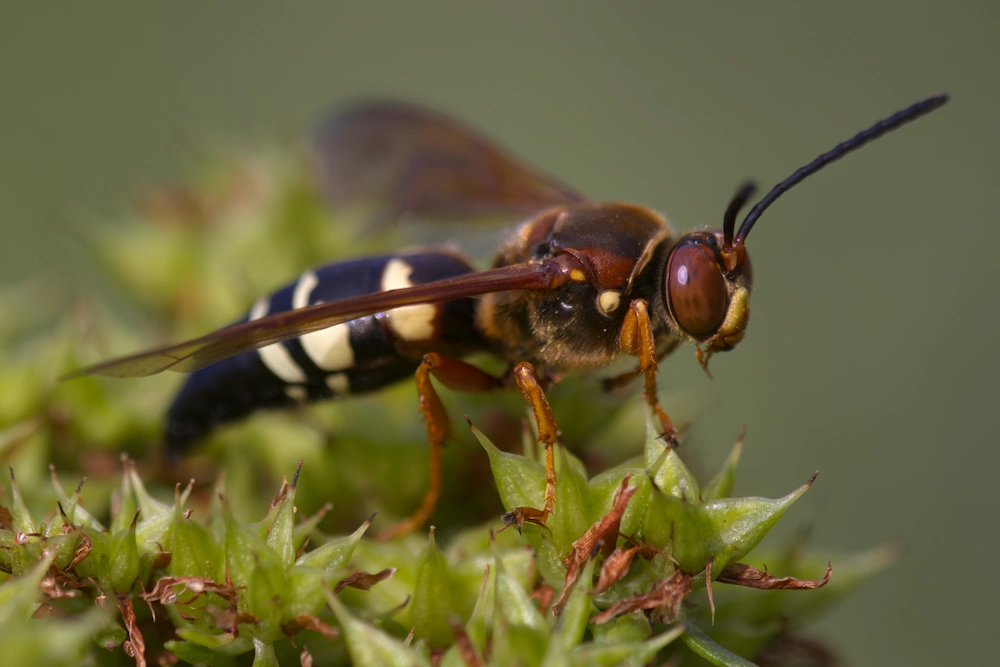
Quite the name for a giant stinger, but it’s very fitting (you’ll see why). Cicada killers are more common in July and August when their young finally mature. Since they average one generation a year, these pests aren’t the most populous ones on our list.
Appearance: Since they’re 1 1/2 to 2 inches long, cicada killers are noticeably larger than the others. They are reddish-black with yellow and black bands around their bodies. Their amber-colored wings are also wider than the typical wasp wings.
Diet: True to their name, cicada killers hunt cicadas. After stunning the loud bugs, female cicada killers take them back to their nests and lay eggs on the bodies. The hatched larvae eat the cicadas until they mature. Adult cicada killers live on flower nectar.
Habitat: Since they’re solitary insects, cicada killers don’t live in huge nests. They create burrows in sandy areas or under lawns. When the young mature, they leave the burrow to start their own families.
Risks: The biggest risk with cicada killers is your lawn getting ruined with their burrows. They will only sting when their nests are fully disturbed, and these stings can be pretty painful. Male cicada killers will charge you if you’re near their burrow, but they can’t sting us.
Mud Daubers
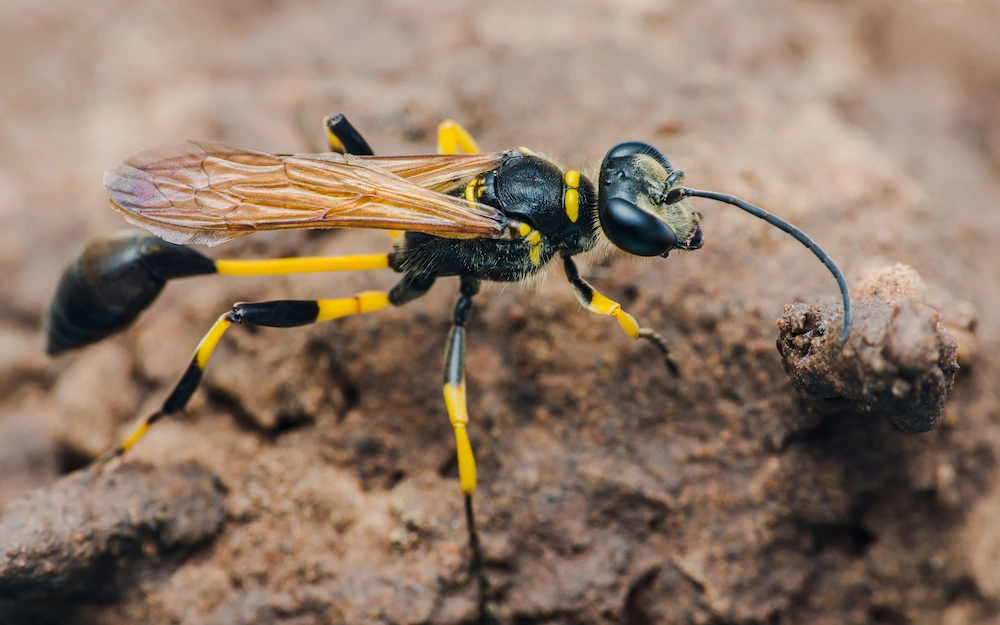
Based on their name, you can probably guess what these pests use for their nests. Mud daubers are one of the stranger-looking stingers we have here. They’re also solitary insects, so you won’t find a massive mud dauber colony anytime soon.
Appearance: These pests are either metallic black or black and yellow in color. They have long bodies with tightly-pinched waists. Their wings are reddish-brown and nearly the length of their bodies. Mud daubers are about 3/4 of an inch to one inch long.
Diet: Adult mud daubers paralyze spiders with their stings, then feed them to their larvae. Crab spiders seem to be their favorite. Once they’re older, mud daubers usually dine on honeydew from aphids, plant nectar, and bodily fluids from their prey.
Habitat: Female mud daubers build small tubes out of mud before they lay eggs. These unsightly nests are usually on the sides of eaves, sheds, barnes, garages, and exterior walls. When mature, the young insects move out and start their own homes.
Risks: Mud daubers are the most docile pests on this list by a country mile. They’re not very defensive of their mud tubes, so stings are pretty rare. If their home is destroyed, they’ll just build a new one. However, other stingers can take over their nest locations if they find it to their liking.
Bald-Faced Hornets
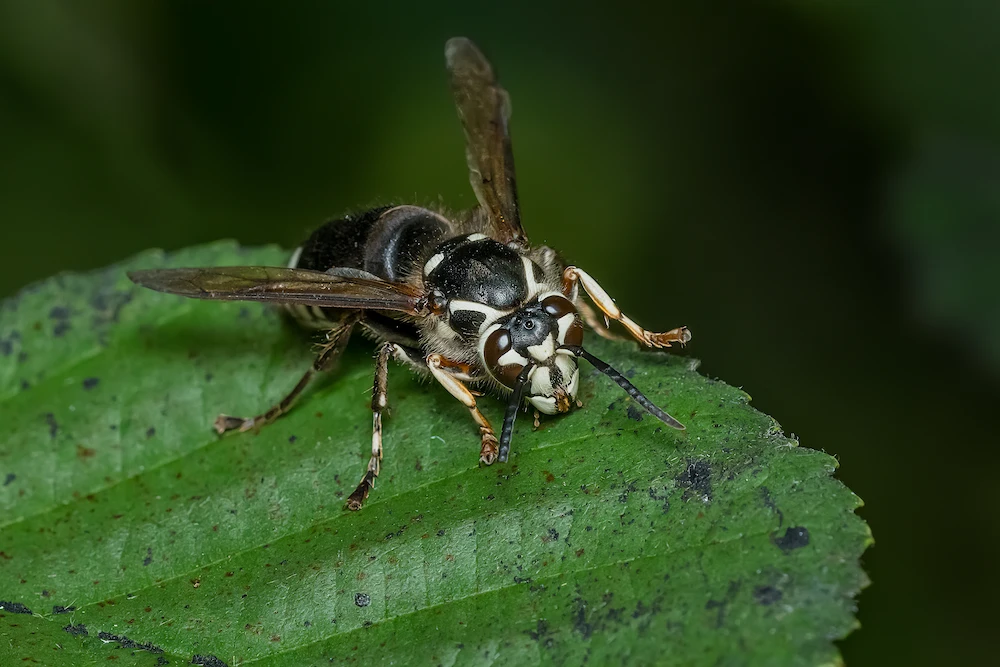
Returning to the aggressive pests, bald-faced hornets are not pests you want to mess with. Their stings pack a punch, especially since they can sting multiple times. These social pests are more active in late summer because the male drones need to fertilize the females before fall.
Appearance: Bald-faced hornets are mostly black with white markings, most notably on their faces (hence the name). They’re about 3/4 of an inch to 1 inch long. These insects look similar to yellow jackets, except bald-faced hornets are a little rounder and lighter in color.
Diet: These pests are formidable predators. They live on pollen, nectar, and a lot of smaller insects. Bald-faced hornets are constantly looking for food sources because they need to feed the hundreds of hornets living in their nest!
Habitat: Speaking of which, these hornets live in papery nests that they keep elevated. These giant gray nests have one entrance and are expanded by the workers throughout the year. The nests are usually hanging from tree limbs, large bushes, and the corners of gutters and roofs.
Risks: Bald-faced hornets are one of the more aggressive stingers in Texas. However, their defensiveness is offset by their nest locations. Since they nest in hard-to-reach places, we run less of a risk of disturbing them. These hornets don’t reuse their nests every year, so they have to find a new safe location every spring.
Scorpions
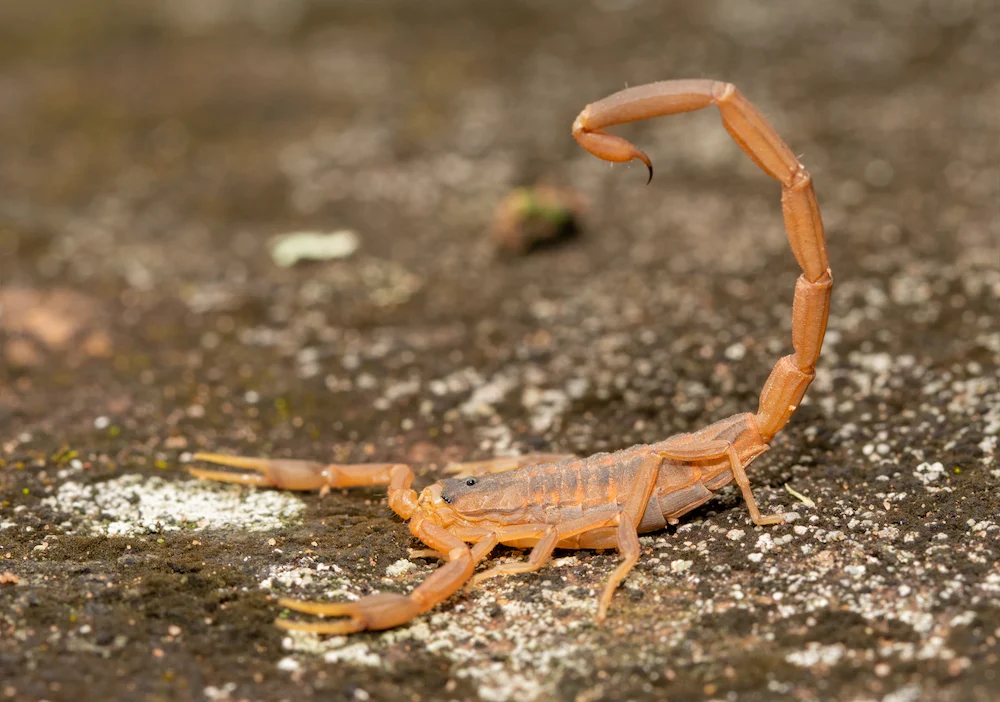
Scorpions are subjectively the most nightmarish pest on our list. One of the most common species we see are striped bark scorpions, so that’s our focus here. If you have scorpions on your property, you’ll want them eliminated ASAP. Females average 30 young in every litter!
Appearance: Texas scorpions are brown or yellow-brown in color with a couple of dark stripes. They’re usually around 2 1/2 inches long, so they’re larger than all of the other stingers (even cicada killers!). Scorpions are known for their long, thin pincers (pedilaps) and barbed tails.
Diet: Unsurprisingly, scorpions eat insects, spiders, lizards, mice, and other scorpions. They use their pedilaps to catch and hold their prey in place. Their tail is equipped with venom glands that release the poison through the stinger on the end.
Habitat: Scorpions are great hiders because they burrow into moist soil that’s covered with leaves and other natural debris. When it’s really hot, they invade houses and buildings. Since they’re flat, scorpions can hide under large items and structures when they aren’t hunting.
Risks: The good news is that Texas scorpions aren’t lethal to humans. Their stings are definitely painful, so we still wouldn’t recommend handling one. Like other stingers, scorpion stings can evoke an allergic reaction in people with these allergies. These pests can live for 3 to 8 years, so consistent scorpion control is essential in every season.
Romney Takes the Sting Out of Summer
Trying to remove an active nest isn’t just a daunting task — it’s a major safety risk. All of these pests are defensive in their own ways, so they won’t appreciate their nests being disturbed. That’s why the licensed technicians of Romney Pest Control are here to help!
Our team removes stinging pests with the utmost care and efficiency. We have the right safety equipment to protect our team while they remove the nest and eliminate the pests. We get the job done without compromising the safety of your household.
For a free quote on the most reliable stinging pest control services in Texas, contact us today!
Citations
Bald-faced hornets. (n.d.). Pest World. Retrieved June 16, 2025, from https://www.pestworld.org/pest-guide/stinging-insects/bald-faced-hornets/
Cicada killer. (n.d.). OSU Extension. Retrieved June 16, 2025, from https://extension.okstate.edu/programs/digital-diagnostics/insects-and-arthropods/cicada-killer-sphecius-speciosus/
Common stinging insects in DFW. (2021, July 9). Gecko Green Pest. Retrieved June 16, 2025, from https://geckogreenpest.com/common-stinging-insects-dfw
Smith, M. (n.d.). Guide to the types of wasps in Texas — Identification and prevention. Envirocon Pest Control. Available at https://www.enviroconpest.com/about/our-blog/wasps-in-texas (Accessed on June 16, 2025).
Striped bark scorpion. (n.d.). Texas A&M AgriLife Extension. Retrieved June 16, 2025, from https://texasinsects.tamu.edu/striped-bark-scorpion/

